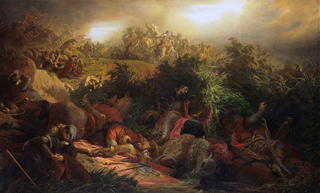
The Battle of Mohács was fought on 29 August 1526 near Mohács, Kingdom of Hungary, between the forces of the Kingdom of Hungary and its allies, led by Louis II, and those of the Ottoman Empire, led by Suleiman the Magnificent. The Ottoman victory led to the partition of Hungary for several centuries between the Ottoman Empire, the Habsburg monarchy, and the Principality of Transylvania. Further, the death of Louis II as he fled the battle marked the end of the Jagiellonian dynasty in Hungary and Bohemia, whose dynastic claims passed to the House of Habsburg.

The siege of Vienna, in 1529, was the first attempt by the Ottoman Empire to capture the city of Vienna in the Archduchy of Austria, part of the Holy Roman Empire. Suleiman the Magnificent, sultan of the Ottomans, attacked the city with over 100,000 men, while the defenders, led by Niklas Graf Salm, numbered no more than 21,000. Nevertheless, Vienna was able to survive the siege, which ultimately lasted just over two weeks, from 27 September to 15 October, 1529.

John Zápolya or Szapolyai, was King of Hungary from 1526 to 1540. His rule was disputed by Archduke Ferdinand I, who also claimed the title King of Hungary. He was Voivode of Transylvania before his coronation, from 1510 to 1526.
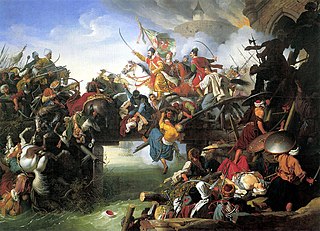
The siege of Szigetvár or the Battle of Szigeth was an Ottoman siege of the fortress of Szigetvár in the Kingdom of Hungary. The fort had blocked Sultan Suleiman's line of advance towards Vienna in 1566. The battle was fought between the defending forces of the Habsburg monarchy under the leadership of Nikola IV Zrinski, the former Ban of Croatia, and the invading Ottoman army under the nominal command of Sultan Suleiman.

The Kingdom of Hungary was a monarchy in Central Europe that existed for nearly a millennium, from 1000 to 1946. The Principality of Hungary emerged as a Christian kingdom upon the coronation of the first king Stephen I at Esztergom around the year 1000; his family led the monarchy for 300 years. By the 12th century, the kingdom became a European power.

Isabella Jagiellon was the queen consort of Hungary. She was the oldest child of Sigismund I the Old, King of Poland, and his Italian wife Bona Sforza.

Baron Nikola Jurišić was a Croatian nobleman, soldier, and diplomat.
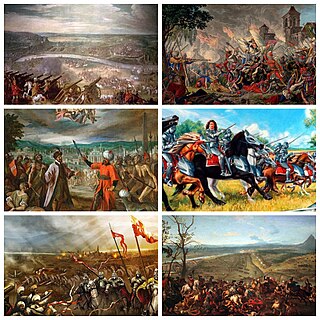
The Ottoman–Habsburg wars were fought from the 16th to the 18th centuries between the Ottoman Empire and the Habsburg monarchy, which was at times supported by the Kingdom of Hungary, Polish–Lithuanian Commonwealth, The Holy Roman Empire, and Habsburg Spain. The wars were dominated by land campaigns in Hungary, including Transylvania and Vojvodina, Croatia, and central Serbia.
The Hungarian Civil War or campaign of 1527–1528 was launched by Ferdinand I, Archduke of Austria and King of Hungary and Bohemia and his Hungarian followers against the Ottoman Turks. Following the Battle of Mohács, the Ottomans were forced to withdraw as events elsewhere in their now massive Empire required the Sultan's attention. Seizing upon their absence, Ferdinand I attempted to enforce his claim as King of Hungary. In 1527 he drove back the Ottoman vassal John Zápolya and captured Buda, Győr, Komárom, Esztergom, and Székesfehérvár by 1528. Meanwhile, the Ottoman Sultan, Suleiman the Magnificent, took no action at this stage despite the pleas of his vassal.

The Habsburg monarchy and the Ottoman Empire waged a series of wars on the territory of the Kingdom of Hungary and several adjacent lands in Southeastern Europe from 1526 to 1568. The Habsburgs and the Ottomans engaged in a series of military campaigns against one another in Hungary between 1526 and 1568. While overall the Ottomans had the upper hand, the war failed to produce any decisive result. The Ottoman army remained very powerful in the open field but it often lost a significant amount of time besieging the many fortresses of the Hungarian frontier and its communication lines were now dangerously overstretched. At the end of the conflict, Hungary had been split into several different zones of control, between the Ottomans, Habsburgs, and Transylvania, an Ottoman vassal state. The simultaneous war of succession between Habsburg-controlled western "Royal Hungary" and the Zápolya-ruled pro-Ottoman "Eastern Hungarian Kingdom" is known as the Little War in Hungary.

The Hungarian–Ottoman wars were a series of battles between the Ottoman Empire and the medieval Kingdom of Hungary. Following the Byzantine Civil War, the Ottoman capture of Gallipoli, and the decisive Battle of Kosovo, the Ottoman Empire was poised to conquer the entirety of the Balkans. It also sought and expressed desire to expand further north into Central Europe, beginning with the Hungarian lands.
The Truce of Constantinople was signed on 22 July 1533 in Constantinople by the Ottoman Empire and the Archduchy of Austria after the Habsburg–Ottoman war of 1529–1533.

The Battle of Gorjani or Battle of Đakovo was fought on 9 October 1537 at Gorjani, a place in present-day Slavonia, between the towns of Đakovo and Valpovo, as part of the Little War in Hungary as well as the Hundred Years' Croatian–Ottoman War.

The Suleiman Bridge was a bridge in Osijek, over the Drava River in Slavonia, eastern Croatia. The bridge had an important role during the Ottoman–Habsburg wars, until it was finally burnt down in 1686.

The siege of Kőszeg or siege of Güns, also known as the German campaign was a siege of Kőszeg in the Kingdom of Hungary within the Habsburg Empire, that took place in 1532. In the siege, the defending forces of the Austrian Habsburg monarchy under the leadership of Croatian Captain Nikola Jurišić, defended the small border fort of Kőszeg with only 700–800 Croatian soldiers, with no cannons and few guns. The defenders prevented the advance of the Ottoman army of over 100,000 toward Vienna, under the leadership of Sultan Suleiman the Magnificent and Pargalı Ibrahim Pasha.
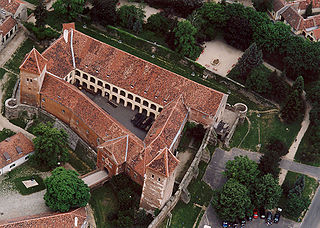
Jurisics Castle, named after Croatian nobleman Nikola Jurišić is located in Kőszeg, Hungary.

The Habsburg–Ottoman war of 1565–1568 was a conflict between the Habsburg Empire and the Ottoman Empire fought mainly on the territory of Hungary and Croatia. During the war, the Turks captured the castle at Szigetvár but the death of Sultan Suleiman I forced them to retreat. The war ended in 1568 after the signing of a peace treaty in Edirne, under which both sides retained their territorial gains, and the Habsburgs further pledged to pay tribute of 30,000 forints to the Turks.

The Habsburg–Ottoman war of 1529–1533 was the first of a long series of wars between the Habsburg and Ottoman Empire.
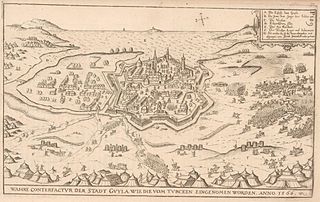
The siege of Gyula was a military siege undertaken by the Ottoman Empire from July to September 1566 on the town of Gyula, situated on the Military Frontier and under Habsburg rule. It was part of the Habsburg–Ottoman war of 1565–1568 and the wider Little War in Hungary. The castle capitulated after two months of resisting the Ottoman attack, making it the longest 16th-century siege in Hungary.

















